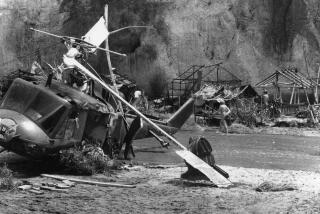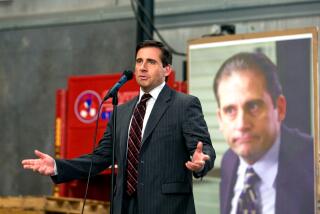Landis Admits Hiring Children Illegally in Filming Fatal Scene
- Share via
In his first public courtroom explanation of the 1982 “Twilight Zone” filming tragedy, director John Landis acknowledged to a jury Wednesday that he had illegally hired the two child actors who, along with actor Vic Morrow, were struck and killed by a crippled helicopter.
But Landis added that he never realized that the spectacular scene, in which the aircraft accidently plummeted out of control after being hit by the fireball of a special-effects explosion, would prove dangerous.
Landis, the first defense witness in the involuntary manslaughter trial that began last September, also disputed statements made on the witness stand by several of the 71 witnesses who were called by the prosecution in 71 days of testimony--including the parents of the two children, Myca Dinh Lee, 7, and Renee Chen, 6.
The parents, in tearful testimony last fall, had said that neither Landis nor other film crew members had told them that their children would be filmed in close proximity to a low-flying helicopter and special effects explosions.
But Landis, speaking in a low-key manner, told jurors Wednesday, “I told them the whole story of the whole segment.”
The film maker added that he did not personally inform the parents that the film crew did not have a necessary state permit to employ the children. Instead, he said, he had directed associate producer George Folsey Jr., a co-defendant, to do so.
Landis explained that, because the state labor commissioner’s office would not grant a permit for late-night filming of children--and not because of fears the filming would be dangerous--”We decided to break the law. We decided wrongly to violate the labor code.”
“Do you recognize, John, that that was wrong?” asked his attorney, James Neal, who led the dramatic day-long direct examination of Landis.
“Yes,” the 36-year-old director firmly replied.
Landis and four associates--Folsey, unit production manager Dan Allingham, special-effects coordinator Paul Stewart and helicopter pilot Dorcey Wingo--are not charged with the illegal hiring of the children. Rather, they each face involuntary manslaughter charges for alleged acts of gross negligence that resulted in the three deaths.
Landis, who has previously made statements in private to federal safety investigators and the county grand jury that eventually indicted him, will continue on the stand this morning.
“I think Mr. Landis has been doing his very best to remember and relate exactly what happened,” Neal, a former Watergate prosecutor from Nashville, told reporters outside court. “It’s very difficult to get up there under these circumstances . . . It’s an ordeal.”
Landis, himself, declined to comment.
But Deputy Dist. Atty. Lea Purwin D’Agostino, who is likely to begin cross-examining Landis sometime today, questioned Landis’ truthfulness and mocked his demeanor as a witness.
“If he’s telling the truth,” the prosecutor said outside court, “so far, at least 19 other people are lying . . . the whole world is lying, according to John Landis, except John Landis.”
D’Agostino asserted that “as a director, he knows precisely what to do--when to appear to be hesitant or when to appear to be confident, when to appear to want to talk to the jury, etc. etc. He knows what he can get out of an actor and he knows what performance he wants to get out of himself. And he’s achieving it.”
Several times during his testimony, when asked to explain such Hollywood terms as pre-production meetings or key grips, the trim-bearded, bespectacled Landis self-assuredly turned and directly addressed the attentive jurors, several of whom were taking notes. At other times, however, Landis appeared a bit fidgety and his statements seemed somewhat rambling.
Landis began his testimony by describing his unlikely climb to the pinnacle of Hollywood, having dropped out of high school in 10th grade to work as a studio “gofer” and as a busboy at a Westwood hamburger restaurant while trying to break into the film business.
Years after directing his first non-studio film at age 21, the low-budget “Schlock,” Landis achieved major box office success with his first studio effort, “Animal House.” Subsequently, he directed such hits as “Trading Places” as well as last year’s “Three Amigos.”
Landis said the idea for “Twilight Zone: The Movie” was first broached by director Steven Spielberg in an early 1982 dinner meeting. Landis proceeded to write a script for a segment of the four-part Warner Bros. film, in which a bigoted man, played by Morrow, would end up “living the results of his own ignorance” by being tormented by Nazis, the Ku Klux Klan and both Vietnamese and American soldiers in Vietnam.
In his testimony, Landis attempted to refute prosecution testimony by witnesses, including the parents, a casting director and a camera operator.
Casting director Marci Liroff had testified that when Landis described the ultimately fatal mock Vietnam battle scene to her a month before the filming, she replied that “it sounded kind of dangerous to me.”
But Landis, when asked by Neal if Liroff made such a statement, replied, “absolutely not.”
Landis also denied telling camera operator Stephen Lydecker “we may lose the helicopter” when Lydecker allegedly warned him the coming scene seemed dangerous.
Landis also said that although Allingham spoke to him about using dummies or midgets instead of the children, the issue of safety never came up. Assistant director Anderson House testified that he warned Allingham of danger and suggested using dummies, but never complained directly to Landis because he “was intimidated” by him.
As for the use of dummies, Landis testified, “I decided no, even in the ‘Twilight Zone’ I didn’t think it would work.”
Throughout his day on the witness stand, Landis contended that he held many meetings on the set with members of his crew, including Stewart and Wingo, in which safety concerns were addressed. D’Agostino has contended that the accident occurred in large part because of a lack of planning and coordination.
More to Read
Only good movies
Get the Indie Focus newsletter, Mark Olsen's weekly guide to the world of cinema.
You may occasionally receive promotional content from the Los Angeles Times.










